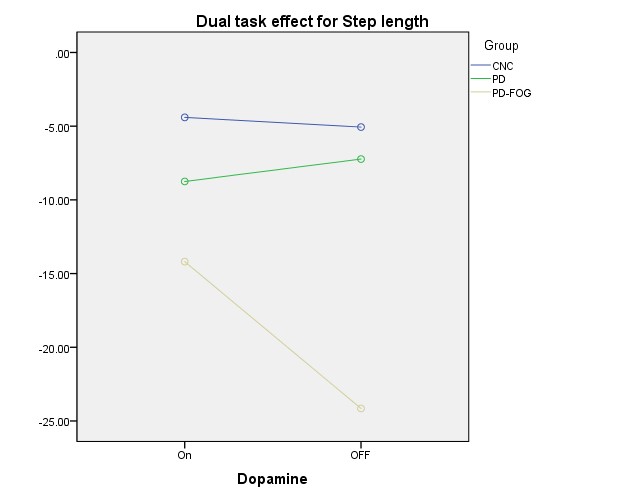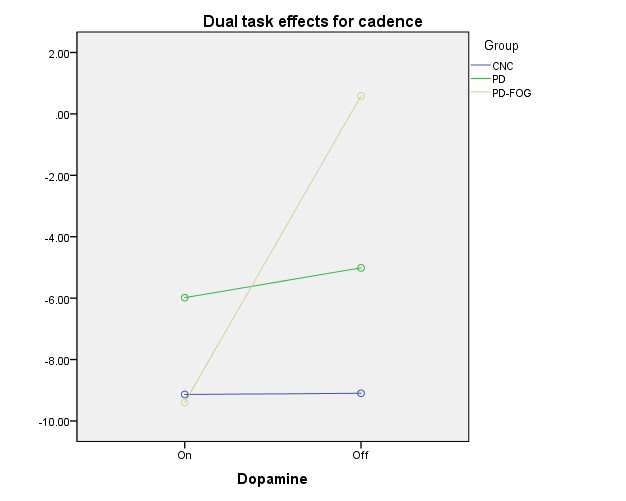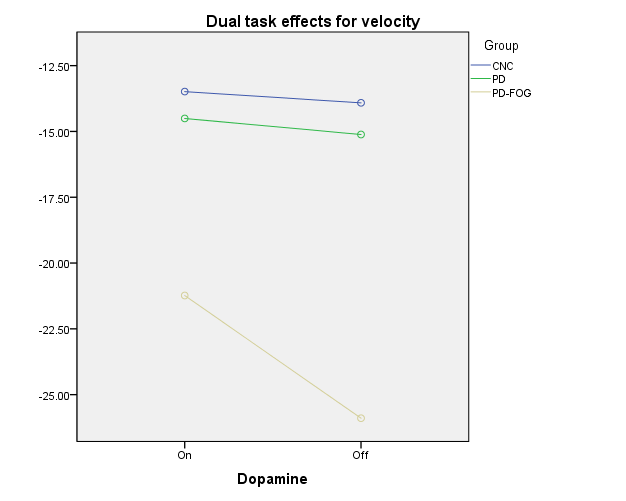Objective: Our purpose in conducting this study was to investigate the effects of dopamine on dual task effects associated with specific gait parameters between individuals with Parkinson’s disease (PD) with and without freezing of gait (FOG) and healthy controls.
Background: PD-FOG is associated with loss of motor automaticity which results in reliance on attentional resources for movement execution. The loss of automaticity in individuals with PD and FOG may, in part, explain FOG and the link between FOG and dual tasking. Few studies have examined the effects of dual tasking on specific temporospatial gait parameters, and no studies have investigated the effects of dopamine on dual task gait parameters or investigated these parameters specifically among individual with FOG.
Method: 55 participants (27 controls, 9 FOG, 19 without FOG (nFOG)) completed temporal spatial gait analysis completed with and without a cognitive dual task in the ON and OFF dopaminergic medication states. Dual task effects (DTE), calculations of the change in performance of a task between single and dual task conditions, were calculated for the following gait parameters: step length, cadence, velocity, and gait variability, for both OFF and ON medication gait. Mixed factorial ANOVAs were conducted on dual task effects on the specific gait parameters noted with the between factor being group (FOG and nFOG), and the within factor being dopaminergic medication status (ON and OFF). Paired sample T-tests were conducted for each group across dopamine status for measures of task prioritization. Task prioritization is concerned how an individual allocates their attention in order to complete a dual task.
Results: There were no differences in age, sex, or Hoehn and Yahr stage (ps>.241), between the control, PD FOG, and nFOG groups. Significant interactions were found for DTEs for: step length (p=.036), cadence (p=.004), and velocity (p=.005), but not for gait variability (p=.088). The PD-FOG group improved in all DTEs in the ON dopamine state while the PD nFOG group demonstrated little if any improvements in the ON dopamine state.
Conclusion: Our results indicate that individuals with FOG exhibit higher DTE, and that the negative dual task effects (dual task costs)related to gait in FOG are, at least in part, mitigated by dopaminergic medications. Dopaminergic medication also does not appear to influence task prioritization during dual task gait.
References: 1. Bekkers EMJ, Dockx K, Devan S, et al. The Impact of Dual-Tasking on Postural Stability in People With Parkinson’s Disease With and Without Freezing of Gait. Neurorehabil Neural Repair. 2018;32(2):166-174. 2. Kleiner AFR, Pagnussat AS, Prisco GD, et al. Analyzing gait variability and dual-task interference in patients with Parkinson’s disease and freezing by means of the word-color Stroop test. Aging Clin Exp Res. 2017; 3. De souza fortaleza AC, Mancini M, Carlson-kuhta P, et al. Dual task interference on postural sway, postural transitions and gait in people with Parkinson’s disease and freezing of gait. Gait Posture. 2017;56:76-81. 4. Ziegler K, Schroeteler F, Ceballos-baumann AO, Fietzek UM. A new rating instrument to assess festination and freezing gait in Parkinsonian patients. Mov Disord. 2010;25(8):1012-8. 5. Vervoort G, Heremans E, Bengevoord A, et al. Dual-task-related neural connectivity changes in patients with Parkinson’ disease. Neuroscience. 2016;317:36-46.
To cite this abstract in AMA style:
J. Longhurst, J. Rider, B. Bluett, M. Landers. The effect of levodopa and cognitive-motor dual interference on gait parameters in PD FOG [abstract]. Mov Disord. 2020; 35 (suppl 1). https://www.mdsabstracts.org/abstract/the-effect-of-levodopa-and-cognitive-motor-dual-interference-on-gait-parameters-in-pd-fog/. Accessed December 29, 2025.« Back to MDS Virtual Congress 2020
MDS Abstracts - https://www.mdsabstracts.org/abstract/the-effect-of-levodopa-and-cognitive-motor-dual-interference-on-gait-parameters-in-pd-fog/



